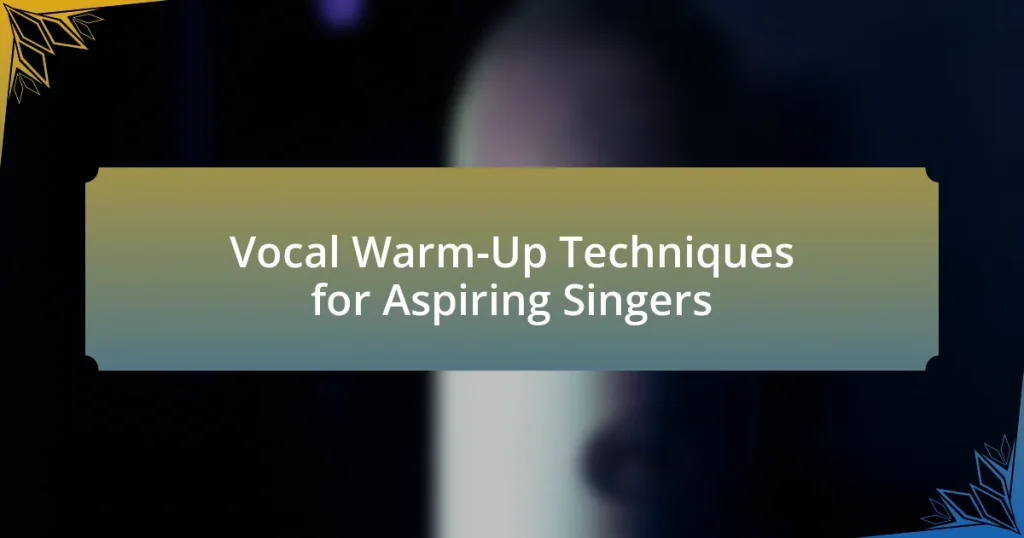Vocal warm-up techniques for aspiring singers are essential exercises designed to prepare the voice for singing and promote vocal health. Key techniques include lip trills, humming, sirens, and scales, each serving specific purposes such as improving airflow, enhancing vocal range, and developing pitch accuracy. The article emphasizes the importance of these warm-ups in reducing the risk of vocal strain and injury, while also highlighting the physiological benefits supported by research. Additionally, it outlines best practices for incorporating warm-ups into a daily routine, the significance of hydration and posture, and resources available for further learning.

What are Vocal Warm-Up Techniques for Aspiring Singers?
Vocal warm-up techniques for aspiring singers include exercises such as lip trills, humming, sirens, and scales. Lip trills help to relax the vocal cords and improve airflow, while humming warms up the voice gently without straining. Sirens, which involve sliding through pitches, enhance vocal range and flexibility. Scales, sung in various patterns, develop pitch accuracy and control. These techniques are widely recommended by vocal coaches and are essential for preparing the voice for singing, as they promote vocal health and performance readiness.
Why are vocal warm-ups important for singers?
Vocal warm-ups are important for singers because they prepare the vocal cords and surrounding muscles for singing, reducing the risk of strain and injury. Engaging in warm-up exercises increases blood flow to the vocal folds, enhances flexibility, and improves vocal range and control. Research indicates that singers who perform vocal warm-ups experience better vocal performance and endurance, as noted in studies by the National Center for Voice and Speech, which highlight the physiological benefits of warming up the voice before extensive use.
How do vocal warm-ups affect vocal health?
Vocal warm-ups positively affect vocal health by preparing the vocal cords for use, reducing the risk of strain and injury. Engaging in warm-up exercises increases blood flow to the vocal folds, enhances flexibility, and improves coordination, which are essential for optimal vocal performance. Research indicates that singers who regularly perform vocal warm-ups experience fewer vocal issues, as these practices help maintain vocal fold hydration and elasticity, crucial for healthy vocal function.
What impact do warm-ups have on vocal performance?
Warm-ups significantly enhance vocal performance by preparing the vocal cords and respiratory system for singing. Engaging in warm-up exercises increases blood flow to the vocal folds, improves flexibility, and helps prevent strain or injury during vocalization. Research indicates that singers who perform warm-ups exhibit better pitch accuracy and vocal range compared to those who do not warm up, as noted in a study published in the Journal of Voice, which highlights the physiological benefits of vocal warm-ups on sound production and overall vocal health.
What types of vocal warm-up techniques exist?
Various types of vocal warm-up techniques exist, including lip trills, sirens, humming, and scales. Lip trills involve blowing air through closed lips to create a buzzing sound, which helps relax the vocal cords. Sirens consist of sliding through pitches in a smooth manner, promoting vocal flexibility. Humming warms up the voice gently and engages the resonators, while scales help develop pitch accuracy and vocal range. These techniques are widely recognized in vocal training and are essential for preparing the voice for singing.
What are the different categories of vocal warm-ups?
The different categories of vocal warm-ups include physical warm-ups, breathing exercises, vocal exercises, and resonance exercises. Physical warm-ups involve stretching and relaxing the body to prepare for singing. Breathing exercises focus on developing breath control and support, essential for vocal performance. Vocal exercises, such as scales and arpeggios, help to improve pitch accuracy and vocal range. Resonance exercises enhance the quality and projection of the voice by focusing on sound placement and resonance. Each category plays a crucial role in preparing the voice for singing and improving overall vocal technique.
How do physical warm-ups differ from vocal exercises?
Physical warm-ups primarily focus on preparing the body for movement and physical activity, while vocal exercises specifically target the vocal cords and the mechanisms of sound production. Physical warm-ups involve activities such as stretching, cardio, and muscle activation to enhance overall physical readiness, which can improve posture and breath control essential for singing. In contrast, vocal exercises include techniques like scales, lip trills, and breath control exercises that directly engage the vocal apparatus, ensuring that the voice is flexible, strong, and ready for performance. This distinction is crucial as effective singing requires both physical readiness and vocal agility, highlighting the importance of incorporating both types of warm-ups into a singer’s routine.
How can aspiring singers effectively incorporate warm-ups into their routine?
Aspiring singers can effectively incorporate warm-ups into their routine by establishing a consistent schedule that includes specific vocal exercises tailored to their voice type. Regular practice, ideally before singing sessions, enhances vocal flexibility and range, which is crucial for performance. Research indicates that vocal warm-ups improve vocal quality and reduce the risk of strain, as demonstrated in a study published in the Journal of Voice, which found that singers who engaged in structured warm-up routines experienced fewer vocal injuries. By dedicating 10 to 15 minutes daily to exercises such as lip trills, scales, and breath control techniques, singers can prepare their voices for demanding performances and maintain vocal health.
What is the ideal duration for vocal warm-ups?
The ideal duration for vocal warm-ups is typically between 15 to 30 minutes. This timeframe allows singers to effectively prepare their vocal cords and muscles for performance or practice. Research indicates that a warm-up of this length can enhance vocal flexibility and reduce the risk of strain, as supported by vocal pedagogy studies which emphasize the importance of gradual vocal engagement.
How often should singers practice warm-up techniques?
Singers should practice warm-up techniques daily. Regular daily practice helps to maintain vocal health, improve range, and enhance overall performance. Research indicates that consistent warm-up routines can lead to better vocal control and stamina, as noted in studies on vocal pedagogy.
What common mistakes should singers avoid during warm-ups?
Singers should avoid rushing through warm-ups, as this can lead to vocal strain and ineffective preparation. Taking time to properly engage the vocal cords and surrounding muscles is essential for optimal vocal performance. Additionally, neglecting to hydrate before and during warm-ups can result in decreased vocal flexibility and increased tension. Failing to incorporate a variety of exercises can also limit vocal range and agility, as diverse techniques are necessary to address different aspects of vocal production. Lastly, ignoring proper posture can hinder breath support and vocal resonance, making it crucial for singers to maintain an aligned and relaxed stance during their warm-up routine.
How can improper warm-up techniques harm a singer’s voice?
Improper warm-up techniques can harm a singer’s voice by causing strain and potential injury to the vocal cords. When singers do not adequately prepare their voices, they risk overexertion, which can lead to issues such as vocal fatigue, hoarseness, or even long-term damage like nodules or polyps. Research indicates that a gradual and structured warm-up routine enhances vocal flexibility and reduces the likelihood of injury, while neglecting this process can result in immediate discomfort and chronic vocal problems.
What signs indicate that a singer is overdoing their warm-ups?
Signs that indicate a singer is overdoing their warm-ups include vocal fatigue, hoarseness, and discomfort in the throat. Vocal fatigue manifests as a reduced ability to produce sound or maintain pitch, while hoarseness often results from strain on the vocal cords. Discomfort in the throat can indicate excessive tension or misuse of vocal techniques. These symptoms suggest that the singer may be pushing their voice beyond its limits, which can lead to potential vocal damage if not addressed.
How can singers tailor warm-up techniques to their individual needs?
Singers can tailor warm-up techniques to their individual needs by assessing their vocal range, identifying specific vocal challenges, and selecting exercises that address those areas. For instance, a singer with a lower vocal range may focus on exercises that enhance resonance and depth, while a singer with higher notes may prioritize agility and flexibility. Research indicates that personalized warm-up routines can lead to improved vocal performance and reduced strain, as evidenced by studies showing that singers who adapt their warm-ups report greater vocal comfort and stamina. By regularly evaluating their vocal health and adjusting their warm-up strategies accordingly, singers can optimize their vocal training and performance outcomes.
What factors should singers consider when choosing warm-up exercises?
Singers should consider their vocal range, the specific demands of their repertoire, and their individual vocal health when choosing warm-up exercises. Vocal range is crucial because warm-ups should target the specific notes and techniques that the singer will be using. The repertoire’s demands influence the type of warm-ups needed; for instance, a singer preparing for a classical piece may require different exercises than one preparing for pop music. Additionally, individual vocal health is essential, as singers must select exercises that do not strain their voices and promote relaxation and flexibility. Research indicates that tailored warm-up routines can enhance vocal performance and reduce the risk of injury, supporting the importance of these factors in the selection process.
How can vocal range influence the choice of warm-up techniques?
Vocal range significantly influences the choice of warm-up techniques by determining the specific exercises that best prepare a singer’s voice for performance. Singers with a wider vocal range may require warm-ups that target both lower and upper registers, incorporating exercises like lip trills and scales that span their entire range. In contrast, singers with a more limited range might focus on exercises that enhance their comfort within their specific vocal limits, such as simple arpeggios or humming within a narrower pitch spectrum. Research indicates that tailored warm-up techniques can improve vocal performance and reduce the risk of strain, emphasizing the importance of aligning warm-up exercises with an individual’s vocal capabilities.
What are some effective vocal warm-up exercises for beginners?
Effective vocal warm-up exercises for beginners include lip trills, humming, and sirens. Lip trills involve blowing air through closed lips to create a buzzing sound, which helps relax the vocal cords and improve breath control. Humming, particularly on a comfortable pitch, warms up the vocal folds gently and increases resonance. Sirens, which consist of sliding through pitches from low to high and back down, enhance vocal range and flexibility. These exercises are widely recommended by vocal coaches for their ability to prepare the voice for singing while minimizing strain.
How can simple scales and arpeggios be used in warm-ups?
Simple scales and arpeggios can be used in warm-ups to enhance vocal agility and improve pitch accuracy. By practicing these exercises, singers develop muscle memory and coordination, which are essential for executing more complex vocal passages. Research indicates that consistent warm-up routines, including scales and arpeggios, can lead to improved vocal performance and stamina, as they prepare the vocal cords for the demands of singing.
What role do lip trills and sirens play in vocal warm-ups?
Lip trills and sirens are essential components of vocal warm-ups as they help to relax the vocal cords and improve vocal range. Lip trills, which involve blowing air through closed lips to create a buzzing sound, promote breath control and reduce tension in the throat. Sirens, which consist of sliding through pitches in a smooth manner, enhance flexibility and facilitate the transition between vocal registers. Research indicates that these techniques can increase vocal agility and stamina, making them effective tools for aspiring singers to prepare their voices for performance.
What are the best practices for maintaining vocal health during warm-ups?
The best practices for maintaining vocal health during warm-ups include proper hydration, gentle vocal exercises, and avoiding strain. Hydration is crucial as it keeps the vocal cords lubricated, reducing the risk of irritation. Gentle vocal exercises, such as lip trills and humming, help to warm up the voice without causing stress. Additionally, singers should avoid shouting or speaking loudly during warm-ups, as this can lead to vocal strain and potential damage. Research indicates that consistent warm-up routines can enhance vocal performance and longevity, supporting the importance of these practices for aspiring singers.
How can hydration impact vocal warm-up effectiveness?
Hydration significantly enhances vocal warm-up effectiveness by ensuring optimal vocal fold function. When the body is well-hydrated, the mucosal layer covering the vocal cords remains lubricated, which reduces friction and allows for smoother vibrations during phonation. Research indicates that hydration improves vocal quality and reduces the risk of strain or injury, as dry vocal cords can lead to hoarseness and decreased vocal range. A study published in the Journal of Voice found that singers who maintained adequate hydration reported better vocal performance and endurance compared to those who were dehydrated. Thus, proper hydration is essential for maximizing the benefits of vocal warm-ups.
What role does posture play in effective vocal warm-ups?
Posture plays a crucial role in effective vocal warm-ups by facilitating optimal breath support and vocal resonance. Proper alignment of the body allows for unrestricted airflow, which is essential for producing clear and powerful vocal sounds. Research indicates that maintaining an upright posture enhances lung capacity and diaphragm function, leading to improved vocal performance. Additionally, correct posture minimizes tension in the neck and shoulders, which can hinder vocal production. Therefore, aspiring singers should prioritize posture during warm-ups to maximize their vocal potential.
What resources are available for aspiring singers to learn more about vocal warm-ups?
Aspiring singers can access a variety of resources to learn about vocal warm-ups, including online courses, instructional videos, and vocal training apps. Websites like Udemy and MasterClass offer structured courses specifically focused on vocal techniques, while YouTube hosts numerous channels dedicated to singing tutorials, such as “The Charismatic Voice” and “Eric Arceneaux.” Additionally, apps like “Vocal Warm Up” and “Sing Sharp” provide guided exercises and warm-up routines tailored for singers. These resources are widely recognized for their effectiveness in enhancing vocal skills and are utilized by both beginners and experienced vocalists.
What online platforms offer vocal warm-up tutorials?
Online platforms that offer vocal warm-up tutorials include YouTube, which features a variety of channels dedicated to vocal training, such as “The Vocal Coach” and “Sing Better,” providing free access to instructional videos. Additionally, platforms like Skillshare and Udemy offer structured courses on vocal techniques, including warm-ups, often created by experienced vocal coaches. These platforms are widely recognized for their educational content and user-friendly interfaces, making them accessible for aspiring singers seeking to improve their vocal skills.
How can aspiring singers benefit from vocal coaching or classes?
Aspiring singers can benefit from vocal coaching or classes by improving their vocal technique, range, and overall performance skills. Vocal coaching provides personalized instruction that helps singers develop proper breathing techniques, vocal control, and pitch accuracy. Research indicates that structured vocal training can enhance vocal quality and stamina, allowing singers to perform more effectively and confidently. For instance, a study published in the Journal of Voice found that singers who participated in regular vocal training showed significant improvements in their vocal range and endurance compared to those who did not receive coaching.
What tips can help aspiring singers maximize their warm-up sessions?
Aspiring singers can maximize their warm-up sessions by incorporating a structured routine that includes vocal exercises, breath control techniques, and hydration. A structured routine ensures that singers engage all aspects of their vocal range and technique, which is essential for vocal health and performance. Vocal exercises such as lip trills, sirens, and scales help to warm up the vocal cords gradually, while breath control techniques, like diaphragmatic breathing, enhance lung capacity and support. Hydration is crucial as it keeps the vocal cords lubricated, reducing the risk of strain. Research indicates that consistent warm-up routines can improve vocal performance and reduce the likelihood of injury, making these practices vital for aspiring singers.















